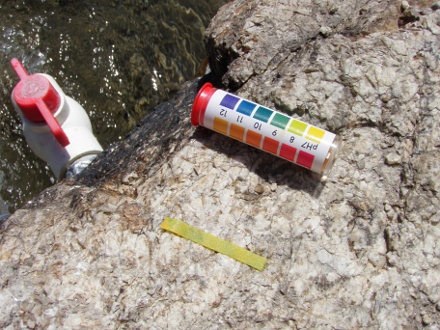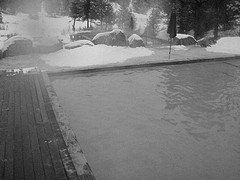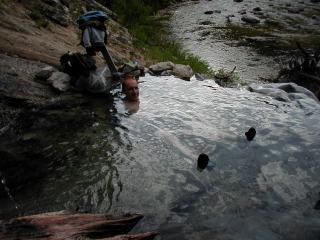Hot Springs Water Quality in
Idaho
The question of how 'safe' is it
to soak in a hot springs in Idaho is a common one. The following
techniques will help you discern if that backcountry hot springs
you tracked down is relatively safe to qualify.
- pH water quality strip
testing
- water flow-through and pool
size
- red spider mites
- wildlife concerns
In regard to safety; I need to
mention that I know many hot springers that will, and have soaked
in just about anything. Many have soaked in stagnant water,
filled to the brim with sludge and silt - horse fly larva laden,
rotten egg smelling hot springs and have survived to tell about
it.
However, that's Idaho. There are hot springs in other states
with reported cases of acanthamoeba (see below). That's not to say
the brain-infecting amoeba doesn't
exist in Idaho, it just might be there haven't been any reported
cases.
Acanthamoeba – an amoeba that
is known to inhabit some hot springs which can enter the
brain through nasal passages and cause meningitis. This is
another reason to keep your head above water while soaking.
Usually, hot springs with acanthamoeba are signed.

pH Water Quality Testing
One method of discerning a 'safe'
soak is to simply test the quality of the water. This can be
done with a pH strip test.
The pH scale runs from 0 to 14, where lower numbers represent acidic mineral content and higher numbers represent alkaline mineral content. A pH of 7 is basically neutral. The more alkaline the better soak (alkaline-based minerals are
typically good for the skin). Acidic-based hot springs are not
ideal because the minerals can be harsh on the skin/body.
In my experience, alkaline soaks have water that feels softer - like it slides over your skin, feels like the water is more dense than normal. The more acidic-based, the more it dries out the skin. I could be wrong on this, but it seems to be a reoccurring theme.
 Gold Fork near Donnelly has the highest recorded pH in Idaho at nearly 10, and as such has an abundance of lithium in the water. The last time I was there I actually saw a bunch of people scooping up the water in cups and slugging it down! Not advisable! Gold Fork near Donnelly has the highest recorded pH in Idaho at nearly 10, and as such has an abundance of lithium in the water. The last time I was there I actually saw a bunch of people scooping up the water in cups and slugging it down! Not advisable!
You can pick up pH test strips at restaurant supply stores for a good deal, just make sure they are the type used for dishwashers.
If you plan on pH testing hot springs, it's important to
remember that pH is directly tied to temperature. In order to
maintain accurate data both need to be recorded at the same
time.
More info on pH
Hustle and Flow
The amount of hot water emanating
from a hot spring and/or into a hot springs fed pool is another
KPI to consider when weighing-in on soak safety. Very little
flow and resulting stagnant water could become a haven for pesky insectoids and poor water quality. Abundant amounts of
silt are
often present within the confines of the pool walls when low
flow and/or stagnant water issues are afoot.
 To
somewhat circumvent the associated risks of soaking in a
stagnant water pool hot springers have been known to bring their
own pool. This is done by placing a tarp into the existing pool;
on-top of the silt and gook, allowing for only clean water to
enter the newly formed pool. Tarps are not left behind either.
Remember the hot springer's motto - pack it in, pack it out. To
somewhat circumvent the associated risks of soaking in a
stagnant water pool hot springers have been known to bring their
own pool. This is done by placing a tarp into the existing pool;
on-top of the silt and gook, allowing for only clean water to
enter the newly formed pool. Tarps are not left behind either.
Remember the hot springer's motto - pack it in, pack it out.
Pro Tip! Time how long it takes
to fill up a quart container with hot water that is used to fill
the pool (if accessible/possible) you plan to soak in. Divide by
15 to get the Gallons Per Minute flow rate.
Red Spider Mite (RSM)
Infestations
Unfortunately, the rate in which
hot springs with reported cases of pesky red spider mites has
been steadily increasing over the years. I'm afraid hot
springers may be inadvertently transporting the little buggars
to previously RSM-free soaks.
View the list of
infected hot springs here...
Walk About for Wildlife
Some hot springs pools are fed by
water at the exact spot where it erupts from the earth, while
other pools are fed by water after prior exposure to atmospheric
and environmental elements - more specifically - wildlife,
before entering the pool. This is typically due to
landscape-based conditions, or more commonly, the need for the
water to 'air cool' prior to entering a pool formation for the
purpose of achieving optimal soaking conditions.
It is always a good idea to scout
around before soaking in a hot pot for the first time. Look for
things like downed carcasses or animal feces in or around the
pool source. Watch out for nasties left behind by pesky
Jackholes as well (AKA trash mongers/jerks/just plain gross
humans). Don't forget to check the bottom of the pool(s) for
broken glass and other treasures.
Wet and Wild
To recap; pH strip testing, pool
size/flow rate and the utilization of general bug/wildlife
information can be used to help assess soak-safety concerns when
visiting new hot springs in Idaho's boundless backcountry.
[TOP] |